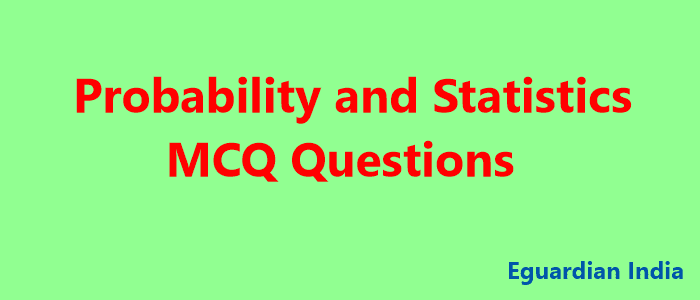Probability and Statistics MCQ Questions with answer
Probability and Statistics MCQ Questions with answer keys for preparation of academic and competitive exams of various institutions in 2024
Q1. If P(A) = 0.35, P(B) = 0.73, P(A∩B) = 0.14, find P(A U B)
Ans. 0.86
Q2. When two dice are tossed, what is the probability of getting four as the sum of the face numbers?
Ans. 1/12
Q3: If A and B are independent and P (A) = 1/3 P(B) = 1/4, find P(A∩B)
Ans. 1/12
Q4. A coin is tossed thrice. What is the chance of getting all heads?
Ans. 1/8
Q5: If P(A) = 0.9, P(B/A) = 0.8, find P(A ÇB)
Ans. 0.72
Q6: If P(A) = 1/3, P(B) = 3/4 , find (P È B) = 11/12, find P(A/B) and P(B/A)
Ans. 2/9, 1/2
Q7: There are 3 true coins and 1 false coin with ‘head’ on both sides. A coin is chosen at random and tossed 4 times. If ‘Head’ occurs all the 4 times. If the head occurs at all the 4 times, what is the probability that the false coin has chosen and used?
Ans. 16/19
Q8: A random variable X has the following probability function
| x | 0 | 1 | 2 | 3 | 4 |
| P(X=x) | c | 3c | 5c | 7c | 9c |
i) Find the value of c.(ii) Find P(X<4), P(X>4), P(0<X<4)
ii) Find the distribution function of X.
Ans. c = 1/25 and 16/25, 9/25, 3/5
Q9: The joint distribution of X and Y is given by
F(x,y) = x+y / 21, x = 1,2,3; y = 1,2 Find the marginal distributions.
Ans. 5/21, 7/21, 9/21, and 9/21, 12/21,
Q10: Two coins are thrown simultaneously and let X denotes the number of heads. Calculate all possible outcomes and find the probability distribution of X. Also calculate the expected values of X.
Ans. Let H denotes the head and T denotes the tail. So all possible outcomes after tossing two coins simultaneously are
Outcomes Number of heads Probability of occurrence
HH 2 2/4 = ½
HT 1 1/4
TH 1 1/4
TT 0 0
So, E(X) = 0.f(x) + 1.f(x) + 2.f(x) = 1. 2/4 + 2. ½ = 3/2
Q11: Let pmf of discrete random variable is p(x) = 1/n, where x = 1,2,3,4,….. Find E(X).
Ans. (n+1)/2
Q12: By throwing a fair die, a game is played. A player wins Rs. 20 if 2 turns up, Rs. 40 if 4 turns up and loses Rs.30 if 6 turns up. And he never loses or gains if any other number turns up. Find the expected value of money won.
Ans. E(X)=5
Q13: X is a random variable whose density function is
Q14: Find the mean of the random variable X, if its pdf is given by
f(x)= 6x(1-x), 0≤x≤1.
Ans. E(X)=1/2
Q15: If the joint pdf of (X,Y) is given by f(x,y)= 24y(1-x), 0≤y≤x≤1, find E(XY).
Ans. E(XY)=4/15
Q16: Assume two random variables X and Y jointly distributed with density function f(x,y)= x+y¸ 0≤x≤1, 0≤y≤1. Find Cov(X,Y).
Ans. -1/144.
Q17. Two events A and B are independent if and only if P(AUB) is equal to which among the following?
a. P(A) U P(B)
b. P(A)*P(B)
c. P(A) ∩ P(B)
d. P(A ∩ B)
Q18. Two or more events are independent if the occurrence of one ____ the occurrence of the other.
a. is the same as the
b. depends on
c. does not affect the
d. differs from the
Q19. All possible outcomes of an experiment are called which among the following?
a. mutually independent events
b. mutually exclusive events
c. independent events
d. exhaustive events
Q20. If f is a function (mapping) from S into the set R of all real numbers and X = f(s), sϵS, then which among the following holds?
a. X is an independent variable
b. X is called a random variable on S
c. S is called a random variable on S
d. S is an independent variable
Q21. Which is not a possible outcome of tossing 3 coins together?
a. HHTT
b. HTHH
c. TTTT
d. All of these
Q22. If (X, Y) is a two-dimensional random variable, and if X & Y are independent then V(X+Y)
a. V(X) + V(Y)
b. V(X) – V(Y)
c. V(X)*V(Y)
d. [V(X)+V(Y)] / sqrt[{V(X)*V(Y)}]
Q23. The measure of association between two random variables is called which of the following?
a. convergence
b. covariance
c. conditional variance
d. conditional expectation
Q24. If X and Y are independent random variables, then E(XY) is equal to which of the following?
a. E(X)+E(Y)
b. E(X)*E(Y)
c. [E(X)+E(Y)] / sqrt[{E(X)*E(Y)}]
d. [E(X)-E(Y)] / sqrt[{E(X)*E(Y)}]
Q25. The moment generating function of the sum of a number of the independent random variable is ____ the product of their respective moment generating functions.
a. greater than or equal to
b. lesser than
c. equal to
d. lesser than or equal to




WONDERFUL Post.thanks for share..more wait .. ?